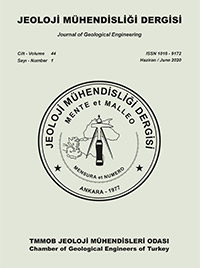Journal of Geological Engineering has following purposes;
• To more effectively reflect the place and importance of the Geological Engineering profession in daily life, which aims to offer the knowledge and experience of the interactions between human and the Earth, considering the natural environment, to the service of humanity in order to provide a safer and healthier living environment,
• To present national and international developments in this field to the knowledge of Geological Engineers,
• To provide an easily accessible and widely participated discussion environment that will strengthen and accelerate the sharing of knowledge and experience among scientists, researchers, engineers and other practitioners who are directlyor indirectly involved in this subject, and to create an opportunity to disseminate them,
• In line with the International Sustainable Development Goals, effective management of natural resources, engineering structures, spatial planning, considering both human and nature respecting the earth dynamics, geological hazards, contributing to the design of resilient environments and solving and developing other problems related to Geological Engineering more effectively,
• Contributing to the development of interdisciplinary research and interoperability principles.
Journal of Geological Engineering covers national and international researches in applied geological engineering domains such as engineering geology, geotechnics, water resources management and hydrogeology, environmental geology and waste management, geothermal, drilling techniques and applications, natural hazards, natural disasters and disaster management. Besides, interdisciplinary studies including civil, mining, geophysics, petroleum, environment, city and regional planning using geosciences data are also accepted.
In this context;
• Suitable site selection research for engineering structures and land use planning,
• Geotechnical site investigations, drilling studies, in-situ and laboratory tests,
• Geophysical methods used in geotechnical studies,
• Geomechanical properties of rocks and soils,
• Slope stability assessments and monitoring techniques,
• Spatial planning studies resistant to dynamic geological processes that adversely affect humans and nature,
• Geographic Information Systems and Remote Sensing applications in the field of geological engineering,
• Natural hazards and risks (earthquake, liquefaction, landslide, sinkhole, medical geology, flood and snow avalanche etc.) assessments,
• Natural disasters and disaster management studies,
• Environmental geology, waste management and site selection studies,
• Management of surface and underground water resources, hydrogeological problems and practical solutions,
• Geological resources management practices, problems, solutions and economic evaluations,
• Research and development of geothermal, mineral and mineral resources and subsurface geological modeling,
• Pollutants and their effects on the ecosystem,
• Natural building materials and ground improvement works,
• Engineering geology in the protection of historical structures and geological monuments,
• Drilling applications in resource exploration and production processes, developments in drilling technologies,
• Research, development and project studies in the field of geological engineering in building production and inspection processes,
• Geological Engineering education and development,
subjects are being interested but other theoretical and applied studies related to the above topics are also published in the Journal of Geological Engineering.
The work must not have been previously published. Five types of paper are published in the Journal of Geological Engineering:
1- Research Article: It is an article in which an original study is presented. The theoretical basis should include sections in which findings and conclusions based on sufficient quantity and quality of data are evaluated in detail. The total length of the manuscript should not exceed the equivalent of 6000 words (10 JMD pages). It is published after being reviewed by at least two members of the Editorial Board.
2- Review: It is an article prepared upon the invitation of the Editor orwith his knowledge, examining the techniques, methods and approaches still used in any field of Geological Engineering in the light of today`s technological developments and his own experiences, and making suggestions and developing them in this respect. The length of the article may vary depending on the subject. There is no obligation to review the Editorial Board.
3- Technical Note: It is an original article that presents a processor technique without relying on theoretical basis, sufficient data and detailed evaluation and is prepared to announce its purpose to earth scientists who can use this processor technique. The length of the manuscript should not exceed 5000 words equivalent (5 JMD pages). It is published after being reviewed by at least two members of the Editorial Board.
4- Research Note: It is an article that presents the preliminary results orfindings of an original, experimental, applied ortheoretical research that is not yet completed, based on incomplete data and findings and superficial evaluations. The aim is to create a discussion environment on the subject by announcing the preliminary findings and results of a study on a current topic, and to provide the contributions of other researchers to the development of the subject. Manuscript length should not exceed 5000 words equivalent (5 JMD pages). It is published after being reviewed by at least two members of the Editorial Board.
5- Erratum: An error notice is issued to correct errors in a published article that was mistakenly created by the authorsor editorial board during the final editing of the article. JMD may be warned of errors by the authorsor readers of the published article. If the authors have alerted the editorial board, a erratum is published as soon as possible. If a reader has alerted the editorial board, the author will be contacted to see if a typo report is appropriate. Readers can contact the Editor. If a Letter to the Editor has been received and a spelling correction is required, the authors of the original article are requested to respond and write a correction to the published Letter to the Editor.

